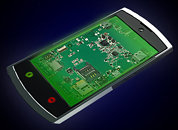Monday, February 11th 2008

NVIDIA Enters CPU Market
NVIDIA today unveiled its first CPU. The APX 2500 is a system-on-a-chip (SoC) product that is aiming for Windows Mobile handhelds. Despite the fact that it is not scheduled to hit the market until late this year, the chip is bound to raise more than just one eyebrow. Basically, the APX 2500 is a cocktail consisting of an ARM11 processor core and lots of technologies borrowed from the GeForce pool. Interestingly, the manufacturer opted not to tout the GoForce brand in this instance, but to put "Ultra-Low Power GeForce" (ULP GeForce) into the spotlight. The GeForce part comes with a programmable pixel shader integrating a programmable vertex & lighting engine. Anti-Aliasing is supported via a CSAA filter for 2D and 3D modes. The chip clocks have not been disclosed, sans the fact that the ARM11 is running at 750 MHz. API-wise, we're talking about OpenGL ES 2.0 and D3D Mobile support. NVIDIA decided to use the shortcut HD AVP (High Definition Audio Video Processor) to describe the video processing capabilities of the SoC. We have to admit that we are a bit surprised that the company did not use a phrase like PureVideo Mobile or simply continues on the PureVideo HD path. On the technology side, HD AVP includes HD video encode and decode (albeit "only" 720p) and NVIDIA claims that the video playback will not eat up CPU cycles, apparently resulting in overall lower power consumption.One of PureVideo's most significant downfalls was the technology's inability to natively decode the VC-1 codec, now predominantly used in HD-DVD and Blu-ray movies. Early on, both ATI and Nvidia were pushing only H.264 and ATI was first to realize that this may be a mistake and released H.264/VC-1 supporting parts to the market. Nvidia's APX 2500 video part now supports all major codec's (H.264, MPEG-4, VC-1 and WMV9).
When it comes to taking pictures and videos, manufacturers will be able to connect up to 12-megapixel CCD/CMOS to the SoC.
APX 2500 natively supports HDMI 1.2 (up to 1280 x 720 pixels), Analog/DVI (1280 x 1024 pixels) as well as composite and S-Video. In a demo device on display in Barcelona, the SoC is coupled with 256 MB of DDR memory, HSDPA, Wi-Fi and Bluetooth on the networking side, while GPS, Mobile TV and a 5-megapixel camera are embedded just to show off that there can be a better iPhone than the current iPhone.
With the above mentioned capabilities, the next generation of GPS, PMP, PDAs and cellphones begins to look more and more interesting to us. The ability to handle 720p video should propel a whole new generation of more affordable in-car audio/video solutions into the market. We could also imagine this technology to be used for other highly-integrated systems, such as IFE (In-Flight Entertainment) systems on aircrafts.
Another interesting aspect of the APX 2500 is that Nvidia is positioning itself as a major player in the Microsoft camp as this product is targeting the Windows Mobile platform only. GPS and PMP markets remain fortresses still to be taken by Microsoft, and this chip could turn the tide in favor of this giant from Redmond, at least on the very high end. Handheld device manufacturer now have another platform choice for 2009 next to Texas Instruments (OMAP3) and Intel (Moorestown). We are still waiting to see what Qualcomm and ATI will have in store.
Source:
TG Daily
When it comes to taking pictures and videos, manufacturers will be able to connect up to 12-megapixel CCD/CMOS to the SoC.
APX 2500 natively supports HDMI 1.2 (up to 1280 x 720 pixels), Analog/DVI (1280 x 1024 pixels) as well as composite and S-Video. In a demo device on display in Barcelona, the SoC is coupled with 256 MB of DDR memory, HSDPA, Wi-Fi and Bluetooth on the networking side, while GPS, Mobile TV and a 5-megapixel camera are embedded just to show off that there can be a better iPhone than the current iPhone.
With the above mentioned capabilities, the next generation of GPS, PMP, PDAs and cellphones begins to look more and more interesting to us. The ability to handle 720p video should propel a whole new generation of more affordable in-car audio/video solutions into the market. We could also imagine this technology to be used for other highly-integrated systems, such as IFE (In-Flight Entertainment) systems on aircrafts.
Another interesting aspect of the APX 2500 is that Nvidia is positioning itself as a major player in the Microsoft camp as this product is targeting the Windows Mobile platform only. GPS and PMP markets remain fortresses still to be taken by Microsoft, and this chip could turn the tide in favor of this giant from Redmond, at least on the very high end. Handheld device manufacturer now have another platform choice for 2009 next to Texas Instruments (OMAP3) and Intel (Moorestown). We are still waiting to see what Qualcomm and ATI will have in store.

13 Comments on NVIDIA Enters CPU Market
AMD(ATI)
and
Intel plans GPUs
Onchip CPU+GPU in near Future!
So tha is the path they must go!
I think!